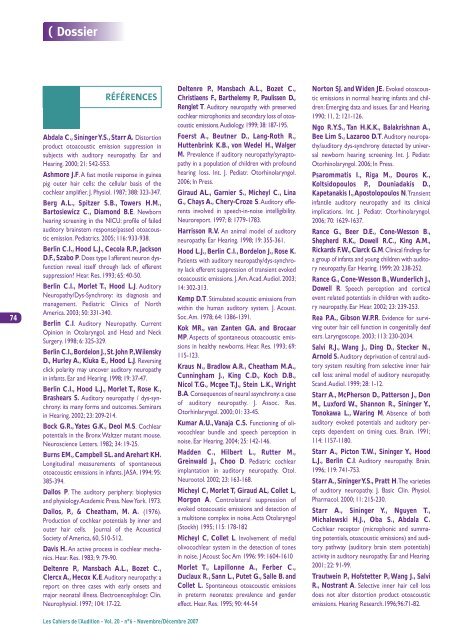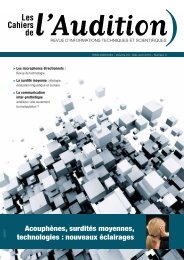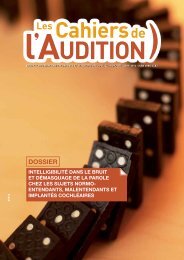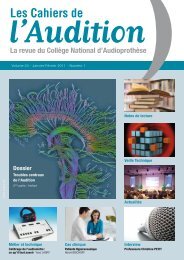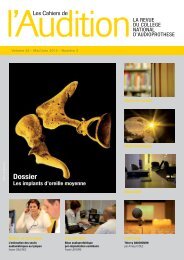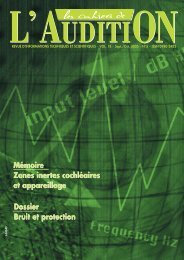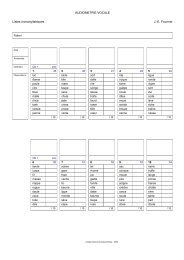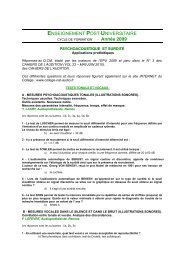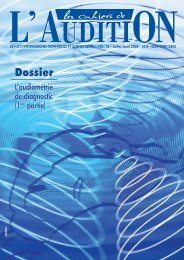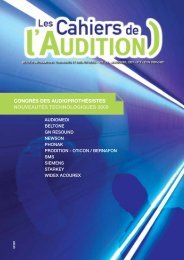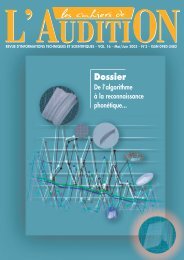la neuropathie auditive / désynchronisation auditive - Collège ...
la neuropathie auditive / désynchronisation auditive - Collège ...
la neuropathie auditive / désynchronisation auditive - Collège ...
You also want an ePaper? Increase the reach of your titles
YUMPU automatically turns print PDFs into web optimized ePapers that Google loves.
( Dossier74RÉFÉRENCESAbda<strong>la</strong> C., Sininger Y.S., Starr A. Distortionproduct otoacoustic emission suppression insubjects with auditory neuropathy. Ear andHearing. 2000; 21: 542-553.Ashmore J.F.A fast motile response in guineapig outer hair cells: the cellu<strong>la</strong>r basis of thecochlear amplifier. J. Physiol. 1987; 388: 323-347.Berg A.L., Spitzer S.B., Towers H.M.,Bartosiewicz C., Diamond B.E. Newbornhearing screening in the NICU: profile of failedauditory brainstem response/passed otoacousticemission. Pediatrics. 2005; 116: 933-938.Berlin C.I., Hood L.J., Ceco<strong>la</strong> R.P., JacksonD.F., Szabo P. Does type I afferent neuron dysfunctionreveal itself through <strong>la</strong>ck of efferentsuppression? Hear. Res. 1993; 65: 40-50.Berlin C.I., Morlet T., Hood L.J. AuditoryNeuropathy/Dys-Synchrony: its diagnosis andmanagement. Pediatric Clinics of NorthAmerica. 2003; 50: 331-340.Berlin C.I. Auditory Neuropathy. CurrentOpinion in Oto<strong>la</strong>ryngol. and Head and NeckSurgery. 1998; 6: 325-329.Berlin C.I., Bordelon J., St. John P.,WilenskyD., Hurley A., Kluka E., Hood L.J. Reversingclick po<strong>la</strong>rity may uncover auditory neuropathyin infants. Ear and Hearing. 1998; 19: 37-47.Berlin C.I., Hood L.J., Morlet T., Rose K.,Brashears S. Auditory neuropathy / dys-synchrony:its many forms and outcomes. Seminarsin Hearing. 2002; 23: 209-214.Bock G.R.,Yates G.K., Deol M.S. Cochlearpotentials in the Bronx Waltzer mutant mouse.Neuroscience Letters. 1982; 34: 19-25.Burns EM., Campbell SL. and Arehart KH.Longitudinal measurements of spontaneousotoacoustic emissions in infants. JASA. 1994; 95:385-394.Dallos P. The auditory periphery: biophysicsand physiology.Academic Press. New York. 1973.Dallos, P., & Cheatham, M. A. (1976).Production of cochlear potentials by inner andouter hair cells. Journal of the AcousticalSociety of America, 60, 510-512.Davis H. An active process in cochlear mechanics.Hear. Res. 1983; 9: 79-90.Deltenre P., Mansbach A.L., Bozet C.,Clercx A., Hecox K.E.Auditory neuropathy: areport on three cases with early onsets andmajor neonatal illness. Electroencephalogr. Clin.Neurophysiol. 1997; 104: 17-22.Deltenre P., Mansbach A.L., Bozet C.,Christiaens F., Barthelemy P., Paulissen D.,Renglet T. Auditory neuropathy with preservedcochlear microphonics and secondary loss of otoacousticemissions.Audiology. 1999; 38: 187-195.Foerst A., Beutner D., Lang-Roth R.,Huttenbrink K.B., von Wedel H., WalgerM. Prevalence if auditory neuropathy/synaptopathyin a popu<strong>la</strong>tion of children with profoundhearing loss. Int. J. Pediatr. Otorhino<strong>la</strong>ryngol.2006; In Press.Giraud AL., Garnier S., Micheyl C., LinaG., Chays A., Chery-Croze S. Auditory efferentsinvolved in speech-in-noise intelligibility.Neuroreport. 1997; 8: 1779-1783.Harrisson R.V. An animal model of auditoryneuropathy. Ear Hearing. 1998; 19: 355-361.Hood L.J., Berlin C.I., Bordelon J., Rose K.Patients with auditory neuropathy/dys-synchrony<strong>la</strong>ck efferent suppression of transient evokedotoacoustic emissions. J.Am.Acad.Audiol. 2003;14: 302-313.Kemp D.T. Stimu<strong>la</strong>ted acoustic emissions fromwithin the human auditory system. J. Acoust.Soc.Am. 1978; 64: 1386-1391.Kok MR., van Zanten GA. and BrocaarMP. Aspects of spontaneous otoacoustic emissionsin healthy newborns. Hear. Res. 1993; 69:115-123.Kraus N., Bradlow A.R., Cheatham M.A.,Cunningham J., King C.D., Koch D.B.,Nicol T.G., Mcgee T.J., Stein L.K., WrightB.A. Consequences of neural asynchrony: a caseof auditory neuropathy. J. Assoc. Res.Otorhin<strong>la</strong>ryngol. 2000; 01: 33-45.Kumar A.U., Vanaja C.S. Functioning of olivocochlearbundle and speech perception innoise. Ear Hearing. 2004; 25: 142-146.Madden C., Hilbert L., Rutter M.,Greinwald J., Choo D. Pediatric cochlearimp<strong>la</strong>ntation in auditory neuropathy. Otol.Neurootol. 2002; 23: 163-168.Micheyl C, Morlet T, Giraud AL, Collet L,Morgon A. Contro<strong>la</strong>teral suppression ofevoked otoacoustic emissions and detection ofa multitone complex in noise.Acta Oto<strong>la</strong>ryngol(Stockh) 1995; 115: 178-182Micheyl C, Collet L. Involvement of medialolivocochlear system in the detection of tonesin noise. J Acoust Soc Am 1996: 99: 1604-1610Morlet T., Lapillonne A., Ferber C.,Duc<strong>la</strong>ux R., Sann L., Putet G., Salle B. andCollet L. Spontaneous otoacoustic emissionsin preterm neonates: prevalence and gendereffect. Hear. Res. 1995; 90: 44-54Norton SJ. and Widen JE. Evoked otoacousticemissions in normal hearing infants and children:Emerging data and issues. Ear and Hearing.1990; 11, 2: 121-126.Ngo R.Y.S., Tan H.K.K., Ba<strong>la</strong>krishnan A.,Bee Lim S., Lazaroo D.T.Auditory neuropathy/auditorydys-synchrony detected by universalnewborn hearing screening. Int. J. Pediatr.Otorhino<strong>la</strong>ryngol. 2006; In Press.Psarommatis I., Riga M., Douros K.,Koltsidopoulos P., Douniadakis D.,Kapetanakis I.,Apostolopoulos N.Transientinfantile auditory neuropathy and its clinicalimplications. Int. J. Pediatr. Otorhino<strong>la</strong>ryngol.2006; 70: 1629-1637.Rance G., Beer D.E., Cone-Wesson B.,Shepherd R.K., Dowell R.C., King A.M.,Rickards F.W., C<strong>la</strong>rck G.M. Clinical findings fora group of infants and young children with auditoryneuropathy. Ear Hearing. 1999; 20: 238-252.Rance G., Cone-Wesson B.,Wunderlich J.,Dowell R. Speech perception and corticalevent re<strong>la</strong>ted potentials in children with auditoryneuropathy. Ear Hear. 2002; 23: 239-253.Rea P.A., Gibson W.P.R. Evidence for survivingouter hair cell function in congenitally deafears. Laryngoscope. 2003; 113: 230-2034.Salvi R.J., Wang J., Ding D., Stecker N.,Arnold S. Auditory deprivation of central auditorysystem resulting from selective inner haircell loss: animal model of auditory neuropathy.Scand.Audiol. 1999; 28: 1-12.Starr A., McPherson D., Patterson J., DonM., Luxford W., Shannon R., Sininger Y.,Tonokawa L., Waring M. Absence of bothauditory evoked potentials and auditory perceptsdependent on timing cues. Brain. 1991;114: 1157-1180.Starr A., Picton T.W., Sininger Y., HoodL.J., Berlin C.I. Auditory neuropathy. Brain.1996; 119: 741-753.Starr A., Sininger Y.S., Pratt H.The varietiesof auditory neuropathy. J. Basic Clin. Physiol.Pharmacol. 2000; 11: 215-230.Starr A., Sininger Y., Nguyen T.,Michalewski H.J., Oba S., Abda<strong>la</strong> C.Cochlear receptor (microphonic and summatingpotentials, otoacoustic emissions) and auditorypathway (auditory brain stem potentials)activity in auditory neuropathy. Ear and Hearing.2001; 22: 91-99.Trautwein P., Hofstetter P., Wang J., SalviR., Nostrant A. Selective inner hair cell lossdoes not alter distortion product otoacousticemissions. Hearing Research.1996;96:71-82.Les Cahiers de l’Audition - Vol. 20 - n°6 - Novembre/Décembre 2007


